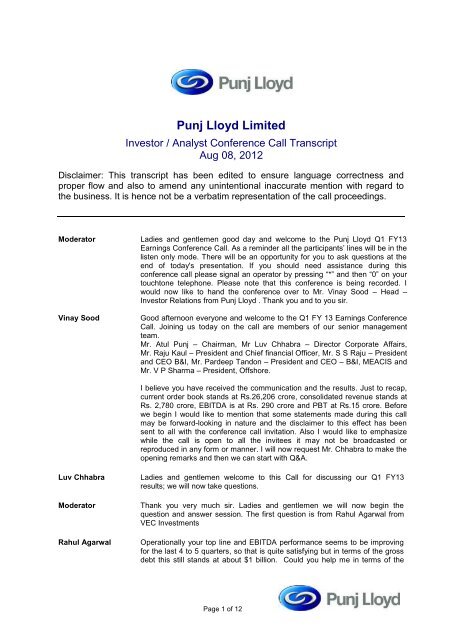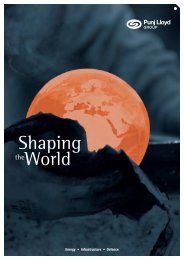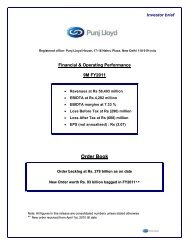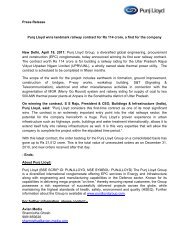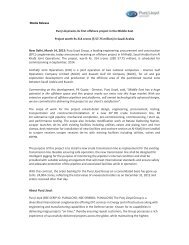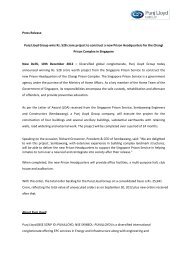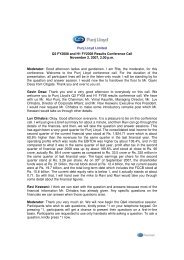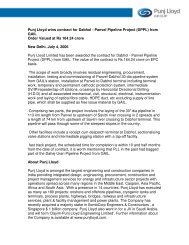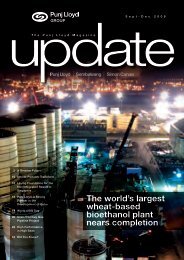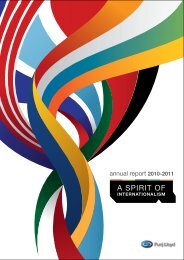âTCS Second Quarter Earnings Conference Callâ - Punj Lloyd Group
âTCS Second Quarter Earnings Conference Callâ - Punj Lloyd Group
âTCS Second Quarter Earnings Conference Callâ - Punj Lloyd Group
Create successful ePaper yourself
Turn your PDF publications into a flip-book with our unique Google optimized e-Paper software.
<strong>Punj</strong> <strong>Lloyd</strong> Limited<br />
Investor / Analyst <strong>Conference</strong> Call Transcript<br />
Aug 08, 2012<br />
Disclaimer: This transcript has been edited to ensure language correctness and<br />
proper flow and also to amend any unintentional inaccurate mention with regard to<br />
the business. It is hence not be a verbatim representation of the call proceedings.<br />
Moderator<br />
Vinay Sood<br />
Ladies and gentlemen good day and welcome to the <strong>Punj</strong> <strong>Lloyd</strong> Q1 FY13<br />
<strong>Earnings</strong> <strong>Conference</strong> Call. As a reminder all the participants’ lines will be in the<br />
listen only mode. There will be an opportunity for you to ask questions at the<br />
end of today's presentation. If you should need assistance during this<br />
conference call please signal an operator by pressing “*” and then “0” on your<br />
touchtone telephone. Please note that this conference is being recorded. I<br />
would now like to hand the conference over to Mr. Vinay Sood – Head –<br />
Investor Relations from <strong>Punj</strong> <strong>Lloyd</strong> . Thank you and to you sir.<br />
Good afternoon everyone and welcome to the Q1 FY 13 <strong>Earnings</strong> <strong>Conference</strong><br />
Call. Joining us today on the call are members of our senior management<br />
team.<br />
Mr. Atul <strong>Punj</strong> – Chairman, Mr Luv Chhabra – Director Corporate Affairs,<br />
Mr. Raju Kaul – President and Chief financial Officer, Mr. S S Raju – President<br />
and CEO B&I, Mr. Pardeep Tandon – President and CEO – B&I, MEACIS and<br />
Mr. V P Sharma – President, Offshore.<br />
I believe you have received the communication and the results. Just to recap,<br />
current order book stands at Rs.26,206 crore, consolidated revenue stands at<br />
Rs. 2,780 crore, EBITDA is at Rs. 290 crore and PBT at Rs.15 crore. Before<br />
we begin I would like to mention that some statements made during this call<br />
may be forward-looking in nature and the disclaimer to this effect has been<br />
sent to all with the conference call invitation. Also I would like to emphasize<br />
while the call is open to all the invitees it may not be broadcasted or<br />
reproduced in any form or manner. I will now request Mr. Chhabra to make the<br />
opening remarks and then we can start with Q&A.<br />
Luv Chhabra<br />
Moderator<br />
Rahul Agarwal<br />
Ladies and gentlemen welcome to this Call for discussing our Q1 FY13<br />
results; we will now take questions.<br />
Thank you very much sir. Ladies and gentlemen we will now begin the<br />
question and answer session. The first question is from Rahul Agarwal from<br />
VEC Investments<br />
Operationally your top line and EBITDA performance seems to be improving<br />
for the last 4 to 5 quarters, so that is quite satisfying but in terms of the gross<br />
debt this still stands at about $1 billion. Could you help me in terms of the<br />
Page 1 of 12
targets and what kind of exploratory measures are we discussing in terms of<br />
replacing our Indian debt with the foreign debt?<br />
Luv Chhabra<br />
Rahul Agarwal<br />
Luv Chhabra<br />
Rahul Agarwal<br />
Luv Chhabra<br />
Rahul Agarwal<br />
There are a couple of things we need to highlight; as volume of business<br />
grows the working capital requirements will increase so that is one reason for<br />
increase in debt and we think the ratio will be in the region of about 2:1 to<br />
1.9:1, , which is around the current level. With regard to what are we trying to<br />
do to reduce the debt, there are a couple of things we are doing, one is we are<br />
looking at our existing assets which have yielded good returns, and will try to<br />
dispose these off over the next 6 to 9 months so that should give us some<br />
amount of headroom in terms of a marginal reduction in the quantum of debt.<br />
In converting some of the debt to foreign debt, I think the current global<br />
environment is challenging. We have made attempts to do this but due to the<br />
number of conditionalitiess existing in trying to raise foreign currency bonds<br />
etc, we are finding it difficult, so we will wait for the economic environment to<br />
stabilize especially in the international market and then take a call and see<br />
how we can progress ahead. I think the longer term view is that when<br />
Sembawang’s coal assets start producing, there is a possibility of listing<br />
Sembawang, sometime towards early of next year and part of that listing will<br />
be a primary sale which will also help in reducing the debt. However that is<br />
over a period of 9 to 12 months.<br />
When you say in terms of asset sales can you specify which of these assets?<br />
There are investments we have in companies like Olive etc which we will try to<br />
unwind. There are real estate assets in the form of office buildings etc, and<br />
these are assets that we will examine over the next 6 to 9 months and try to<br />
liquidate.<br />
There are two other reasons as well, to decrease debt, one was obviously<br />
some money getting freed up from our legal issues and second was obviously<br />
in terms of release of working capital from Libya, so are these both things on<br />
track?<br />
The effort to sort out and release the money that is stuck up in litigation is an<br />
ongoing exercise. They are pretty much on track but like most legal issues it is<br />
hard to pinpoint when exactly the penny falls and we're able to recover the<br />
money. A number of cases are in the hands of High Courts or in the hands of<br />
the arbitrators. We are unable to commit at this point of time when exactly that<br />
money will flow. On Libya as we mentioned last time, the upstream drilling<br />
operations have started and the second rig has moved out; it has gone on to<br />
Gabon where it is working for an Oil India operation so that is a positive<br />
development. On the infrastructure side, the discussions have started with<br />
HIB (a) to renegotiate contracts and (b) now that the client has declared and<br />
accepted that it was a force-majeure situation, claims have been filed and we<br />
are in discussion with the clients to recover our claims for idling of equipment,<br />
damage of assets and idling of manpower, evacuation of manpower and after<br />
that we will start the process of commencing work as soon as the client is<br />
ready to pay us money. Now that the elections are over, a government is in<br />
place, the transition from NTP to the newly elected government is happening,<br />
we expect activities to progress in Libya over the next 3 to 6 months both on<br />
the infrastructure and on the oil and gas projects.<br />
New order wins and the order pipeline which we foresee for the balance of the<br />
year, so in terms of new orders we got about 1800 to 2000 crore of order this<br />
quarter?<br />
Page 2 of 12
Raju Kaul<br />
Rahul Agarwal<br />
Luv Chhabra<br />
Moderator<br />
Kesvinder Suri<br />
Luv Chhabra<br />
Kesvinder Suri<br />
Raju Kaul<br />
Kesvinder Suri<br />
Luv Chhabra<br />
Kesvinder Suri<br />
Luv Chhabra<br />
Moderator<br />
Pritesh Chheda<br />
Luv Chhabra<br />
Yes Rs 2,000 crore.<br />
And in terms of expected tenders or expected orders where we have put our<br />
bids can you just give me some flavor in terms of many big projects we expect<br />
to fructify in the next nine months?<br />
We cannot answer a leading question. Needless to emphasize the order<br />
backlog is slightly above Rs 26,000 crore, bidding pipeline continues to be<br />
good, in some markets very good and in some markets not so good but we<br />
continue to expect the momentum to be maintained for order booking in the<br />
next three quarters of this year.<br />
The next question is from Kesvinder Suri from Span Capital Services.<br />
First about the disinvestment of the non-core assets and investments, would<br />
there be an indicator of quantum as to how much they would be?<br />
It is hard to say right now, when that happens we will certainly let you know.<br />
What quantum of your orders in your order book is from Libya?<br />
Around Rs 4,000 crore.<br />
What is the amount of claim under the force majeure clause which we planned<br />
to file for?<br />
Its a matter of dialogue and discussion with the clients, we will file a number of<br />
claims and the client will not accept all claims so I think once we see a finality<br />
on the discussions that number will become known.<br />
And out of the order book of 26,000 crore, what quantum would you term as<br />
slow-moving or almost stagnated orders?<br />
Other than Libya , everything else is going planned.<br />
The next question is from Pritesh Chheda from Emkay Global Financial<br />
Services<br />
If you could just recap the orders which are there of Libya in the backlog,<br />
because we had cancelled few orders a few quarters back, so if you could<br />
justly recap that what is included in the backlog now and if I have to look at<br />
your comment in the presentation, which one of that order has actually started<br />
executing?<br />
We have orders in the infrastructure, oil and gas and the third one is an<br />
ongoing work, which was a drilling operation by a subsidiary called <strong>Punj</strong> <strong>Lloyd</strong><br />
Upstream, where 2Nos, 1500 HP rigs were deployed on the eastern side of<br />
Libya where the oil is present. The first business to start off the ground in<br />
Libya post-conflict is the drilling operation. Of the 2 rigs, one rig has moved<br />
out to Gabon to do work for Oil India. The second rig has started drilling<br />
operations in Libya. On the infrastructure side, the client has recognized in<br />
their written communication that a force majeure situation has arisen as a<br />
consequence of the conflict and we have now filed our claims with the clients,<br />
so the process of dialog with the client is on and we are hoping that with the<br />
new government having come in place now and elections having been<br />
completed, this process of resuming our operations on the infrastructure<br />
Page 3 of 12
project will happen in the next 6 months and I think the same applies for oil<br />
and gas contracts.<br />
Pritesh Chheda<br />
Raju Kaul<br />
Pritesh Chheda<br />
Atul <strong>Punj</strong><br />
Pritesh Chheda<br />
Atul <strong>Punj</strong><br />
Pritesh Chheda<br />
Atul <strong>Punj</strong><br />
Pritesh Chheda<br />
Atul <strong>Punj</strong><br />
Pritesh Chheda<br />
Luv Chhabra<br />
Have we billed anything to the client before the conflict started?<br />
Yes, there are pending bills.<br />
Basically the renegotiations whenever they happen and in whatever form it<br />
happens, there is a chance that the orders would come back to us and there<br />
is a chance that the orders may not come back to us both those possibilities<br />
do exist?<br />
Let me put this in perspective. We had five infrastructure contracts, we had<br />
one oil and gas contract and we had one drilling contract. The drilling contract<br />
has already been renegotiated; of the 2 rigs we have redeployed, one rig in<br />
Libya, the second rig has been moved to Gabon for another contract which we<br />
have with Oil India as was mentioned just now by Mr. Chhabra. Of the five<br />
infra projects 2 have been renegotiated and we are waiting for their signal to<br />
restart work. The revised terms have been agreed which are pretty favorable<br />
and balance key discussions are based on the claims that we have filed with<br />
them which they have asked us to file. It is not something that we have<br />
arbitrarily done and the same thing holds true for the pipeline contract. We're<br />
not seeing any signals of there being a cancellation, in fact we have seen a<br />
strong pull from them for us to finish the job.<br />
In the remarks for Sembawang, we mentioned about some coal assets.Could<br />
you tell us more about that?<br />
Sembawang is a 50% owner of a coal mine in Indonesia in the Kalimantan<br />
region, that mine is currently under development and we expect exploitation of<br />
coal to happen towards the early part of next financial year.<br />
Could you comment on some reserves or potential there?<br />
We are 50% investors in the mine and the total reserves of that mine are<br />
currently estimated at slightly over 50 million tons.<br />
Then my question about the Middle East and the order pipeline or markets<br />
there and how it shaping up and your comments?<br />
We do not want to give too much detail in terms of forward-looking information<br />
but the deal pipeline is fairly robust as was mentioned. The Middle East is<br />
probably emerging along with South-East Asia to be as the strongest market.<br />
There is a lot of push now in the infrastructure space. The oil and gas and<br />
petrochemicals side carries on the way it was, with the same momentum, but<br />
there is a huge amount of spend now going on in the social infrastructure<br />
space as well which means power, desalination, hospitals, schools, highways.<br />
A lot of that activity is happening, much more than we have seen in the past,<br />
so I think we are quite comfortably placed to capture the opportunities that<br />
present themselves.<br />
Which countries are kind of better off in that particular zone?<br />
Well I think the big oil producing countries are obviously right ahead, so you<br />
have Abu Dhabi, Qatar, Saudi Arabia which are right on top and then you<br />
Page 4 of 12
have emerging markets which are looking to stabilize their institutions like<br />
Iraq, which will be a big market as well.<br />
Pritesh Chheda<br />
Atul <strong>Punj</strong><br />
Pritesh Chheda<br />
Luv Chhabra<br />
Pritesh Chheda<br />
Luv Chhabra<br />
Pritesh Chheda<br />
Raju Kaul<br />
Pritesh Chheda<br />
Raju Kaul<br />
Pritesh Chheda<br />
We have heard that Koreans who are competing in this market have brought<br />
down the terms of trade significantly in the new order inflow, your comments<br />
there. How are the terms of trade now in the business which is flowing from<br />
these regions?<br />
There are tendered projects and negotiated projects. Our focus is more on the<br />
negotiated projects than tender projects and it is true that the Koreans have<br />
swamped large contracts but they do this every 10 years. This is the third time<br />
that I am witnessing it, when I started my career they were known to sweep<br />
the markets. They then followed it 10 years later after they got burned and<br />
now this is the third wave that we are seeing but this is something which<br />
happens generally in our business. We have the same issues in India, where<br />
we have a lot of Indian companies who tend to change the terms of trade as<br />
you call it to unworkable numbers, so that’s just a part of the course of our<br />
business.<br />
On the forex side since we deal in multiple forex so just wanted to understand<br />
the policy that we have deployed. <strong>Second</strong> if you can give us in the<br />
consolidated revenues how much is the rupee revenue in it and how much<br />
would be other forex revenues and which forex should one look at for a better<br />
understanding or analysis?<br />
On the first part, our policy is that to the extent possible, the currency in which<br />
we earn is the currency in which we spend or borrow. As an example, for our<br />
projects in the Middle East (almost all the currencies in the Middle East are<br />
linked to the US dollar) our effort is most of the expenditure of procurement<br />
will be in the US dollar and the borrowings will be in the local currency and<br />
that’s a process and philosophy we tend to follow across all the regions. The<br />
same process is followed in Singapore and the same, to the extent possible,<br />
is followed in Indonesia. There are some markets where this is not always<br />
feasible but we try to stick to this policy.<br />
You said that the expenditure would be in dollar and the borrowings would be<br />
in the local currency?<br />
I gave the example of Middle East because there all the currencies are<br />
pegged to the US dollar at a fixed exchange rate. The dollar andlocal currency<br />
is freely exchangeable at a fixed exchange rate.<br />
And if you could give us the composition of your revenue in a broader rupee<br />
and the other currencies and also for the debt?<br />
If you look at the top line around 35% is from operations in India and 65% are<br />
from operations abroad so that is the rough breakup.<br />
And most of that 65% should it be dollar?<br />
It is again a mix of different currencies, it is part in Singapore dollars, dollars<br />
and small part in Malaysians Ringgit as well.<br />
And for the debt part if you could?<br />
Page 5 of 12
Atul <strong>Punj</strong><br />
Moderator<br />
Rajesh Agarwal<br />
Raju Kaul<br />
Rajesh Agarwal<br />
Raju Kaul<br />
Rajesh Agarwal<br />
Raju Kaul<br />
Rajesh Agarwal<br />
Luv Chhabra<br />
Rajesh Agarwal<br />
Luv Chhabra<br />
Rajesh Agarwal<br />
Luv Chhabra<br />
Rajesh Agarwal<br />
Debt is taken in the currency in which we are receiving money against the<br />
contract, so if your question is trying to figure out what is our exposure, we<br />
generally are fairly hedged because we are not borrowing in dollars to spend<br />
in India or for projects where we have been paid in rupees for example. We<br />
borrow in rupees for projects for which we are being paid for in rupees.<br />
The next question is from Rajesh Agarwal from Moneyore<br />
Can I have the breakup of other operating income and other expenditure?<br />
Other operating income will primarily constitute income from scrap sale, some<br />
provisions write back, primarilyy on account of these things and some forex<br />
gain.<br />
Other expenditure has jumped significantly so can I have the breakup of that?<br />
It is primarily employed related, trades and taxes, hire charges, lease rentals.<br />
Why that has gone up significantly from 530 crore last quarter to 630 crore<br />
this quarter?<br />
It has gone up in proportion to the top line.<br />
We have seen a significant reduction in contract charges and a significant<br />
increase on employee cost, so is it that we are doing more of the work inhouse<br />
by our own employees instead of outsourcing them to contractors, is<br />
this a strategy or is it due to some phase in the project?<br />
I don't think you can establish a pattern. We have a multitude of projects<br />
across different geographies. The execution philosophy varies for every<br />
project so this can change depending on which project is at a particular stage<br />
of the execution cycle. Please don't interpret this as a trend which indicates<br />
that we are subcontracting more work or doing more work in-house. That's a<br />
call we take for every project at the start or at the time of bidding itself.<br />
So this cannot be extrapolated to other projects for future results?<br />
Not necessary, I don't think this is the trend.<br />
Have we again changed our depreciation policy because depreciation has<br />
also increased significantly from 70 crore from 93 crore?<br />
The reason for that is in the last quarter there was a write-back, (if I can call it<br />
a write back) in depreciation for the reason that the life of the drilling rigs is<br />
much longer than what was originally being provided in the depreciation<br />
policy. Accordingly, on those two rigs, the depreciation rate was reduced, and<br />
there was a write back of depreciation.<br />
The same assets remains with us or with the same kind of assumptions, if the<br />
depreciation has increased significantly that means we have added more to<br />
the fixed assets?<br />
Raju Kaul Last year there has been an increase in assets to the extent of about Rs 600<br />
crore. The total capital expenditure has been in that ballpark range, mainly<br />
project related equipments and then there has been a capitalization of our<br />
Page 6 of 12
defense plant at Malanpur which is over 100 crore. The plant has been<br />
commissioned and its operational now.<br />
Rajesh Agarwal<br />
Luv Chhabra<br />
Rajesh Agarwal<br />
So this Rs 93-94 crore should be, what we should see across the balance<br />
three quarters as well?<br />
Unless there are some very significant increases in plant and equipment for<br />
construction, it will be in this range.<br />
As per my understanding there was a very small amount of work left in, under<br />
Sirte basin around 11 crore. So if we do that project which will require less<br />
amount of time and effort then cash flow should be expected out from that<br />
project itself and that too fast?<br />
Luv Chhabra<br />
Rajesh Agarwal<br />
Luv Chhabra<br />
Rajesh Agarwal<br />
Luv Chhabra<br />
Rajesh Agarwal<br />
Luv Chhabra<br />
Rajesh Agarwal<br />
Luv Chhabra<br />
The drilling project is an ongoing operation, we go from one spot to another<br />
spot to the third spot which the client identifies. Rigs are mobile, so we will drill<br />
in a particular spot till oil is discovered and then we go to the second spot and<br />
then we go to the next spot in an ongoing project.<br />
So cash flows can start flowing from that project around say up to a quarter or<br />
so?<br />
Actually cash flows have already started.<br />
Any figure that you can crystallize on?<br />
The cashflows have started in the 1st <strong>Quarter</strong> of this year. We will have<br />
steady state achieved in the next quarter and will give those numbers next<br />
quarter<br />
The operating margins have expanded quite significantly? So any particular<br />
reason for the same and can we extrapolate this into future, I know you don't<br />
give future projections but explanations about this margin, any significant<br />
change in the business environment or just the projects are going through<br />
such a phase where we book such amount of margins?<br />
Margins are based on a percentage of completion method so that should be<br />
an indicator of trend for what the future holds for the existing projects. Unless<br />
there are any surprises in any of our existing projects, that margin should<br />
hold.<br />
A kind of change in the outstanding order book, we are moving out of<br />
infrastructure gradually, say infrastructure was supposed to be a low margin<br />
business and if we are getting more orders, like we got another order for<br />
Phase-2 of Qatar, so that kind of, should play positively on our margins going<br />
forward?<br />
Directionally yes, but you must go back and see why the infrastructure<br />
proportion increased. It is primarily due to a significant amount of instability in<br />
the Middle East region which was created by a series of crises in various<br />
countries. Now with the oil prices seemingly in the $90-$100 range and<br />
indications are that range is likely to continue, we think, the orders are flowing<br />
back in the Middle East region.<br />
Page 7 of 12
Rajesh Agarwal<br />
Luv Chhabra<br />
Rajesh Agarwal<br />
So we are again gaining ground on our main forte which is oil & gas and<br />
pipelines so infrastructure will gradually reduce and those things will increase<br />
so our margins will directionally move up from 8% to 9% which we have<br />
experienced in the last one or two years?<br />
I'm not saying that infrastructure is not our forte. Let me correct that<br />
impression, we have companies that do only infrastructure work; Sembawang<br />
is an excellent example of a company that has for the last two years delivered<br />
consistently robust returns in the infrastructure sector. We are just talking of<br />
the proportion of our infrastructure business business vis-à-vis the oil and gas.<br />
As a proportion if it comes down will be a directionally positive to our overall<br />
margins. Can we have any kind of assumptions for tax expense, we work<br />
across different geographies so where we make profit and loss somewhere<br />
else but tax expenditure is very huge so if I could make any assumptions or<br />
estimation on what would be the tax expenditure for the full year, how would I<br />
do that and on what basis?<br />
Atul <strong>Punj</strong> I think it is very difficult to predict because we are working across 21<br />
geographies, every region has different taxation rates. With different<br />
revenues and profitability in each region how it will affect tax rate is difficult to<br />
predict.<br />
Moderator<br />
Prashant Jain<br />
Atul <strong>Punj</strong><br />
Prashant Jain<br />
Our next question is from Prashant Jain from HDFC Fund<br />
Mr. <strong>Punj</strong> can you elaborate on the capital expenditure last year In a time,<br />
when our balance sheet is already under so much of stresstypically we see<br />
contracting companies take equipments on hire so what has been the strategy<br />
here because the CAPEX seems to be disproportionately large to an outsider<br />
given the uncertain environment and the stretched balance sheet.What is the<br />
capital expenditure program for the current year and also if you'd like to<br />
comment the capital expenditures finally what the balance sheet shows is, in<br />
my opinion higher than what was probably guided on our expectations during<br />
the course of last year?<br />
We have always maintained our CAPEX is linked directly with project<br />
requirements. Now when we picked this large project in Myanmar, there is no<br />
rental operation in Myanmar. If we look at the rental rates that we are able to<br />
get there, we can pay for the new equipment in about the nine months rental<br />
period.. We base our decisions on acquisitions simply on each project<br />
requirement. When you talked about disproportionate, there are different<br />
verticals in the company that have different needs of equipments. Pipelines for<br />
example are much more equipment intensive than the civil job, particularly a<br />
building job where we have a couple of tower cranes, we will have a couple of<br />
batching plants, we will have a couple of excavators and that's about it.<br />
Pipelines generally are much more equipment intensive and that's what is<br />
affecting our capex. We don't really plan any annual CAPEX; our CAPEX is<br />
directly linked with project wins. The philosophy as a company is that at the<br />
end of a project, if there is no need for the equipment, we will sell that<br />
equipment. That policy that has been put in to effect now and you will see that<br />
this number of the CAPEX or the equipment number will go up and down<br />
based on the project needs that we have in the company rather than<br />
equipment sitting idle, waiting for an imminent project.<br />
But in the current environment would it be a very prudent strategy where<br />
balance sheet is already stretched and we need to generate some free cash<br />
flows, this way you will keep on buying equipments for one project and then<br />
Page 8 of 12
you are also taking a risk on the sale value of the equipment at the end of the<br />
project?<br />
Atul <strong>Punj</strong><br />
Luv Chhabra<br />
Moderator<br />
Pankaj Chopra<br />
Raju Kaul<br />
Pankaj Chopra<br />
Luv Chhabra<br />
Pankaj Chopra<br />
Luv Chhabra<br />
But it also depends on the availability of the particular equipment that we need<br />
for example we want to rent pipelayers which are required in pipeline<br />
construction and we can’t find them and we cant rent an equipment it is not<br />
available. While we can find standard equipment like excavators, dozers,<br />
trucks and dumpers but the specialist equipment that we need in pipelines<br />
we cannot find anywhere unless of course we go to competitor and<br />
competitors are not going to rent it to us. Internationally if you look at the<br />
Middle East market, it is possible to rent equipment.. If you look at Africa it is<br />
not possible to rent equipment, so it is all conditioned on a specific project.<br />
I just want to add on what Mr. <strong>Punj</strong> said, with regard to our philosophy of<br />
acquiring equipment for new projects and at the end of these projects, if there<br />
is no requirement for such equipment, we will dispose it off. When evaluating<br />
the project economics, the cost of acquiring the equipment and the disposal<br />
value is considered and only then a decision is taken whether we should<br />
acquire or rent. So this is really built into the project economics when we are<br />
evaluating a project.<br />
The next question is from Pankaj Chopra from Shanti Asset Management<br />
My question is on margins you mentioned that 65% of your mix is largely nonrupee<br />
based so I would assume that a large part of the margin improvement<br />
had been helped by the currency. Would you like to comment on that please?<br />
This proportion has been there for quite a few years. It is not as if it has<br />
dramatically altered in favor of a foreign component vis-à-vis an Indian<br />
component, AND there is no significant change in that proportion.<br />
But the rupee depreciated significantly this quarter and the benefit of that<br />
essentially comes in, it is a translational benefit?<br />
This quarter there hasn’t been such a significant depreciation of rupee. The<br />
depreciation you are referring to happened over the period of previous 3 or 4<br />
quarters. There has not been such a significant change in the rupee-dollar<br />
exchange rate and don’t forget we don’t just deal with the rupee-dollar<br />
exchange rate, there are multiple currencies in which we get our revenues. It<br />
is very hard to peg it to a particular rate in a particular geography.<br />
You mentioned earlier that you were intending to shift your borrowings into US<br />
dollar, the attempt was there and later on in the presentation in response to a<br />
question you mentioned that most of the projects that you do, you do your<br />
funding in the same currency so there is something which I missed in<br />
understanding. Our borrowings are completely based on the projects already<br />
and if that is the case then why are we trying to shift the borrowings?<br />
To the extent it is possible, we borrow in that particular geography but there<br />
are some geographies where local borrowing is not possible example some<br />
geographies like Libya where local borrowing was not possible. For these<br />
markets if there is a rupee borrowing, the endeavor was to try to shift it to a<br />
currency which is closely linked to the currency in which we are earning<br />
revenues.<br />
Page 9 of 12
Pankaj Chopra<br />
Luv Chhabra<br />
Pankaj Chopra<br />
Atul <strong>Punj</strong><br />
Pankaj Chopra<br />
Atul <strong>Punj</strong><br />
Pankaj Chopra<br />
So could you comment on the level of the difference between the borrowing<br />
and the project handling, you said 65% is non-rupee based so would it be fair<br />
to assume that maybe 50% is non-rupee borrowing, is that a fair assessment?<br />
We don’t have an exact percentage of this right now, I think Raju can give you<br />
details later.<br />
My question moves to the interest rate because if I look at the interest rates<br />
figures over the last so many quarters, it has just been moving up and of<br />
course we could get into the granularity but directionally I would assume that<br />
the interest rates in the places you borrow is not as high so if the interest rates<br />
if I calculate based on the numbers given it comes to a pretty high number so I<br />
just want to understand how this interest rate figure has interest cost<br />
percentage?<br />
I think you can get the details with Raju, but basically the intent of the<br />
organization is that currently our global interest rate that we are paying is<br />
about 11.2%. We are attempting to drop this interest rate to the extent<br />
possible by shifting our loans, to drop this number because that goes straight<br />
to the bottom-line. We are conscious of the fact that (a) we have to bring down<br />
our debt which we have already started with and (b) is at the same time we<br />
are attempting to do whatever we need to do bring down the cost of money.<br />
We have a lot of borrowings in India which are term borrowings, which are<br />
attracting a higher rate of interest, and are not project linked. These are the<br />
borrowings that we are attempting to shift to a lower interest bearing currency.<br />
Now it’s really how quickly the banks move that determines whether we are<br />
able to do it this quarter or next quarter but we are genuinely attempting to do<br />
whatever we need to do bring down our cost of money as well as the quantum<br />
of money that we have.<br />
The reason for asking this question is just to understand if <strong>Punj</strong> structurally<br />
disadvantaged because of this cost of capital while it operates in countries<br />
where competition is from players who have a much lower cost of capital<br />
despite having borrowing in the same place that which you operate?<br />
No, we are not structurally at a disadvantage in the competitive space but yes<br />
in terms of our overall financial base it is a taking a toll on us which is why we<br />
are looking at this very aggressively. which is what can we do to bring down<br />
both these elements ie the total quantum as well as the price.<br />
If I compare your asset turnover over the last 6-7 years, there has been a<br />
huge amount of deterioration although they have been improving over the last<br />
couple of years but the number has fallen from 4 to much lower than 2 and the<br />
ROCE number is much lower. Could you comment on your ROCE targets by<br />
how do you see that improving. Is there a structural change in the business<br />
per se because of the environment and do you foresee the environment<br />
changing, if that has been the cause?<br />
Atul <strong>Punj</strong><br />
The ROCE numbers that we have on a consolidated basis Is that ROCE<br />
number has gone from 9.5 to 9 and our fixed asset turnover has gone from 4<br />
to 3.5 over the last year so I don't see the significant drops that you<br />
mentioned. When you talk about lot of these numbers you got to remember<br />
that year and half ago we got hit with what I called as a perfect storm. With<br />
Libya suspension of work,.we had $2 billion worth of backlog at the time that<br />
suddenly got into the suspended animation; obviously our financial numbers<br />
Page 10 of 12
are going to get short. Now we have been basically consolidating our own<br />
position and are now seeing the upturn trend that has started. I believe it will<br />
gather full steam towards the end of the year and we are clearly seeing the<br />
worst of it behind us now. What we ask is that when you look at all these<br />
ratios, please keep that at the back of your mind.<br />
Moderator<br />
Naveen Jain<br />
Luv Chhabra<br />
Naveen Jain<br />
Luv Chhabra<br />
Naveen Jain<br />
Raju Kaul<br />
Naveen Jain<br />
Luv Chhabra<br />
Naveen Jain<br />
The next question is from Naveen Jain from JM Financial Institutional<br />
Securities<br />
On your mine in Indonesia, could you please tell us how much investment we<br />
have done in this particular project and further is to be done going forward?<br />
The mine is currently under exploration so the infrastructure development is<br />
happening, overburden is being removed, the roads are being done, etc. The<br />
final license and permits are still pending and that is the current status. The<br />
current estimate is that by the 4th <strong>Quarter</strong> of this year coal exploitation will<br />
start and that’s when coal revenues will start too. I don’t have the exact<br />
number of total capital investment planned in this mine. If I recollect, it is in the<br />
region of about SG$15 or SG$18 million.<br />
And second question was on the Libyan orders about Rs 4,000 crore, which is<br />
there in the order book right now. Mr. <strong>Punj</strong> gave a good detail about which<br />
orders are these but if you could just quantify individually like how much is<br />
trading contract worth or how much is oil and gas contract worth and how<br />
much are those two infrastructure orders worth?<br />
The drilling contract is an ongoing contract where we are paid a day rate by<br />
the Libyan oil company. So if the rig operates we are paid approximately<br />
$20,000 a day and if the rig is idle, we are paid at 60 or 70% of that day rate.<br />
The other two segments are the five infrastructure projects and the oil and gas<br />
projects. Raju can separately, off-line, give you details of order backlog for<br />
each contract. The total of value of these contracts are approximately Rs<br />
4,000 crore.<br />
And if you can just share the figure as you mentioned that in other operation<br />
income ratio there is some Forex income, could you please give the amount?<br />
It is around Rs 40 crore.<br />
One last question was on your tax and in the last 3 to 4 years you probably<br />
have paid a lot of tax because of the way our business is structured ,individual<br />
subsidiary had paid taxes, I would assume that some of the subsidiaries that<br />
would have reported losses in the last 2-3 years - we will probably have a lot<br />
of accumulated losses in those subsidiaries so is there a possibility going<br />
forward in future let’s say in the next year when the business turns around in<br />
that particular subsidiary also that we can have some substantial tax savings<br />
or something like that because of the accumulated losses or something I just<br />
wanted to understand that aspect?<br />
It is possible - as an example( and we’re not saying that is the case - but as<br />
an example if there is prior loss in Indonesia and the business is hugely<br />
profitable in the curent year we can offset that loss. It also depends on the tax<br />
laws in that particular country and whether they permit offset of previous<br />
losses.<br />
Is there any genuine possibility we are seeing right now or still not visible as of<br />
now?<br />
Page 11 of 12
Luv Chhabra<br />
Moderator<br />
Pulkit Patni<br />
Luv Chhabra<br />
Moderator<br />
Rahul Agarwal<br />
Luv Chhabra<br />
Moderator<br />
Atul <strong>Punj</strong><br />
Moderator<br />
It is hard to comment, if we have paid tax in Malaysia and we have a loss<br />
hypothetically in Indonesia, we can’t offset the two.<br />
The next question is from Pulkit Patni from Goldman Sachs<br />
I just wanted a rough sense of what the capital expenditure numbers for FY13<br />
is expected to be. If you could just give a ballpark number that would also be<br />
fine?<br />
Every instanceof capital expenditure for plant and equipment for the project is<br />
based on the economics of that particular project and the availability of hired<br />
equipment and then a call is taken whether we should use hired equipments<br />
or whether we should buy equipment. At the end of the project if there is no<br />
requirement for the equipment, such equipments will be sold off. Our capex<br />
depends on the type of project wins, the segment -whether they are pipeline,<br />
whether they are EPC, whether they are infrastructure etc -and on the basis of<br />
this analysis the Board approves the capital expenditure for each and every<br />
project.<br />
The next question is from Rahul Agarwal from VEC Investments.<br />
On your material cost, does it have any one-time or any inventory hold up cost<br />
in 1st <strong>Quarter</strong> because it seems that material to sales as a ratio or as a<br />
percentage has come down a bit compared to the previous quarter?<br />
Firstly there isn’t any write-off. It is difficult to establish a trend eg if we have a<br />
large EPC contract the quantum of material and equipment procured for the<br />
client can be very large vis-à-vis a pure construction contract or a pure<br />
pipeline contract where the client supplies the pipeline; thus proportions are<br />
very different in our different segments of business. I don’t think you should<br />
use this as a trend to see whether this will increase or decrease in the next<br />
quarter. It will depend on each project and the cycle in which that particular<br />
project is.<br />
I now hand the conference over to Mr. <strong>Punj</strong> for closing comments.<br />
Thanks so much for being on the call. We’re hoping this year is a good year<br />
coming forward now and we value your support and the time you spend on<br />
the company. Hope to be in touch again soon.<br />
Thank you gentlemen of the management. On behalf of <strong>Punj</strong> <strong>Lloyd</strong> that<br />
concludes this conference call.<br />
Page 12 of 12


